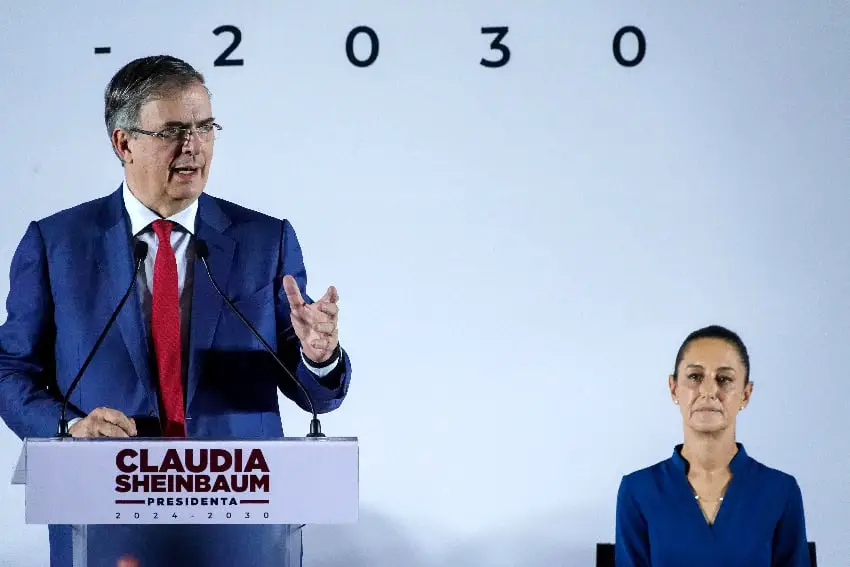Lila Abed, director of the Mexico Institute at the Wilson Center in Washington, D.C., is an international relations specialist with extensive experience in government and media affairs.
As both Mexico and the United States face presidential and administrative transitions, Abed answered questions from MND Chief News Editor Kate Bohné about this key moment for Mexico-U.S. relations.
Immigration has been a hot topic in this volatile U.S. election campaign, while Mexico is also continuing to see record numbers of migrants and asylum-seekers. How do you think Sheinbaum’s policies might differ from AMLO’s when it comes to migration and border security?
President-elect Claudia Sheinbaum’s 100-point government plan provides few, but important proposals to deal with the waves of migrants that are entering the country with hopes of reaching the United States. One of the fundamental issues on the U.S.-Mexico bilateral agenda is migration, and depending on who wins the White House on Nov. 5, leaders on both sides of the border will have to establish new guidelines on immigration matters.
Current migration trends pose a risk for both nations. Mexico is no longer just a transit country; it has gradually become a destination country for migrants. According to data from Mexico’s Ministry of the Interior and U.N. Migration, in 2022, Mexican authorities registered 444,109 encounters with individuals in an irregular migration situation. In 2023, encounters soared to 782,176, an increase of 77% compared to the previous year and the highest number recorded in the country. In this sense, Mexico and the United States are grappling with similar migration patterns, and both countries will have to deepen bilateral — and regional — cooperation to confront growing migratory flows.
Sheinbaum’s political platform and government plan do not offer a comprehensive strategy to address migration flows in the country. It calls for improving the institutional structure, political coordination, and increasing resources to deal with migrants. It also seeks to create a permanent mechanism that establishes closer cooperation with the countries in the region to address the root causes of migration, with a particular focus on human rights.
The Sheinbaum administration is likely to maintain López Obrador’s policies on managing migration flows in cooperation with the United States. In various public statements, Sheinbaum has stated that she plans to ask the United States to invest more resources to address the root causes that drive migration. Sheinbaum, like AMLO, believes that poverty is the key driver of migration and plans to ask for more U.S. economic assistance to Central America and others through support of Mexico’s social programs. That said, Sheinbaum’s six-year term will depend greatly on the guidelines set by the next president of the United States on this matter.

As fentanyl continues to cause an epidemic of overdoses in the U.S., and is also on the rise in parts of Mexico, how do you think Sheinbaum’s administration will differ (or not) from AMLO’s in its approach to security collaboration with the U.S.?
Claudia Sheinbaum’s proposed security strategy could potentially differ from her soon-to-be predecessor’s “hugs not bullets” strategy by strengthening intelligence gathering and better coordination among all agencies responsible for upholding Mexico’s security. Mexico’s first female president plans to combat insecurity through the creation of a National Intelligence System, which hopes to coordinate the military, civilian forces, financial agencies, as well as the judicial branch. It also seeks to enhance the investigation capabilities of local police forces.
Her strategy aims to stop the illicit flow of arms into the country through ports of entry at the U.S. southern border (70% of arms enter through these ports). To combat illicit financing networks, Sheinbaum hopes to combat criminal organizations by having the Intelligence Financial Unit, the Ministry of Public Citizen Security and the Attorney General’s office work closer together.
Essentially, she proposes better coordination between municipal, state and federal security agencies. Her plan also seeks to implement prevention programs for youth that are vulnerable to joining organized crime groups through a program that she implemented during her tenure as Mexico City Mayor called “Youth Unite Neighborhoods,” which focuses on individuals ages 12 to 29 living in communities with high levels of crime and violence.

Despite these changes, Sheinbaum has committed to continue consolidating the AMLO-created National Guard under the Ministry of Defense, potentially deepening what many experts have called the militarization of former civilian security forces and consequently, diminishing opportunities for deeper cooperation with U.S. security agencies.
AMLO’s proposed judicial reform and other constitutional and legal reforms, which he hopes to approve in September, could also prove detrimental to Sheinbaum’s incoming administration.
How do you think Sheinbaum’s cabinet appointments thus far have been viewed by Washington?
Many of Claudia Sheinbaum’s cabinet appointments have been well-received by Washington. The designation of Marcelo Ebrard as Secretary of Economy and Juan Ramón de la Fuente as Secretary of Foreign Relations sends a positive signal to Mexico’s top trading partner that Sheinbaum’s government is serious about deepening and strengthening trade relations with its North American partners ahead of the 2026 USMCA review.
Both Ebrard and De la Fuente will be tasked with responding to pending trade disputes against Mexico under USMCA, as well as attracting more foreign direct investment (FDI) by taking advantage of the nearshoring phenomenon. A key individual responsible for attracting FDI to Mexico is Altagracia Gómez, who will lead the newly created Council for Regional Development and the Relocation of Companies.
Another key appointment was Alicia Bárcena as Secretary of Environment and Natural Resources, an issue that is of particular interest to U.S. policymakers and U.S. companies. The continuation of Rogelio Ramírez de la O as Secretary of Finance and Public Credit signals stability and certainty for sound economic management.

What do you see as the biggest challenges for Mexico ahead of the USMCA review in 2026?
According to the USCMA, the governments of Mexico, Canada and the United States agreed to convene six years after its entry into force (July 1, 2020) to assess the effectiveness of the Agreement, consider recommendations of action raised by any of the three parties, and decide how to best address the issues posed.
The USMCA has so far produced remarkable results, with a 50% increase in the trade of goods and services within North America and a 136% growth in investment. It has created and supported millions of jobs and has successfully addressed multiple trade disputes through dispute settlements mechanisms embedded in the Agreement. In 2023, Mexico became the U.S.’ top trading partner, with two-way trade totaling just shy of US $800 billion, surpassing Canada and China. The USMCA’s legal and regulatory framework has instilled certainty, predictability and clear rules for all three parties involved.
The 2026 USMCA review could entail a rather difficult process. With presidential elections coinciding in Mexico and the United States, and with national elections occurring in Canada, how the review unfolds will largely depend on how the leaders of all three nations approach the review process. There are pending trade disputes that the U.S. and Canada presented against Mexico’s biotech/GMO corn and energy policies.
The increasing presence of China in Mexico is also a cause of concern for policymakers, legislators and private sector representatives in the United States. Regardless of who wins the White House in November, USMCA issues, including Mexico’s position on labor, energy, and agriculture and Canada’s position on dairy, digital tax, and others, will certainly be points of contention for the next U.S. president.
Canada and Mexico presented a trade dispute against the United States for its strict interpretation of certain automotive rules of origin that was inconsistent with the USMCA. The panel agreed with Mexico and Canada and the U.S. is expected to remedy its position or face suspension of benefits by its North American partners. It is fundamental that all parties comply with the outcomes of USMCA dispute settlement mechanisms to maintain confidence in USMCA rules and provide predictability and certainty to traders and investors. Failure to do so could disincentivize other parties found in violation of the USMCA from adopting measures to reverse non-conformity measures, potentially undermining a sound implementation of the Agreement.

The review process could also serve as a unique opportunity for all three governments to address issues not included in the USMCA, like developing a digital regulation framework for artificial intelligence, cybersecurity [or] expanding the Environmental Chapter, among others. Deepening North America integration is essential to strengthen the region’s competitiveness vis-à-vis other global trading powers.
What are you most optimistic about in U.S.-Mexico relations in the next five years? What are you most concerned about?
The U.S.-Mexico relationship is unique to others around the world as it affects the daily lives of millions of people living on both sides of the border. The scope of bilateral relations between the United States and Mexico is broad and deep, bound by strong geographical, historical, cultural and commercial ties. Strengthening cooperation on all issues on the bilateral agenda, including migration, security, and trade, is essential for advancing the individual and mutual interests of both nations. The U.S. and Mexico are deeply intertwined, interconnected, and interdependent, and only through deeper and broader collaboration efforts will they be able to achieve a stronger bilateral relationship and a prosperous and competitive North America.
As in any relationship between neighbors, disagreements are bound to happen, but the next leaders of both countries will be responsible for working together to resolve their differences. Potential issues of concern, as previously mentioned, are resolving pending trade disputes and China’s investment in Mexico ahead of the 2026 USMCA review, the increasing flow of migrants into Mexico and the United States and rebuilding mutual trust between U.S. and Mexican security agencies.
Mexico News Daily
